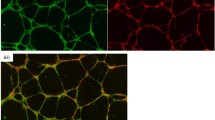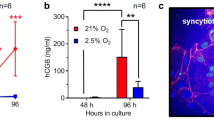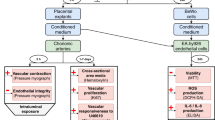Abstract
Objective
Many processes that are involved in cellular invasion, including blastocyst implantation, placental development, and rapidly growing tumors, occur in reduced oxygen environments. It has been surmised that oxygen tension could regulate the cytotrophoblast ability to differentiate and, as a consequence, to express proteins that are critical for placentation. The objective of the current investigation was therefore to test the hypothesis that placental tissues and trophoblast cells in culture, under low oxygen tension, release angiogenic factors that could affect vascular behavior and invasive potential, thus providing a link between abnormal placentation and maternal vascular abnormality.
Methods
Functionally active term placental explant culture and trophoblast cultures were used to demonstrate the secretion profiles of angiogenin and vascular cell adhesion molecule-1 (VCAM-1), and the real-time quantitative reverse transcriptase polymerase chain reaction (RT-PCR) technique was employed to demonstrate the mRNA expression under both normoxic and hypoxic conditions.
Results
A significant increase in the secretion (P <.01) and mRNA expression (P <.01) of angiogenin and a significant decrease in the secretion (P <.04) and mRNA expression (P <.03) of VCAM-1 from both term placental explants and trophoblast cultures subjected to hypoxia in vitro were observed.
Conclusion
Because the primary defect in uteroplacental insufficiency is placental maldevelopment probably associated with hypoxia in situ, this study provides molecular evidence to indicate that the differential expression and secretion of angiogenic factors may play an important role in these pathologic conditions.
Similar content being viewed by others
References
Fandrey J. Hypoxia-inducible gene expression. Respir Physiol 1995;101:1–10.
Hu CJ, Pan Y, Simon MC. Oxygen and angiogenesis. In: Hoying JB, ed. Genetics of Angiogenesis. Oxford, UK: BIOS Scientific, 2003:85–100.
Pijnenborg R. Trophoblast invasion and placentation: morphological aspects. Troph Res 1990;4:33–50.
Khong TY, De Wolf F, Robertson WB, Brosens I. Inadequate maternal vascular response to placentation in pregnancies complicated by pre-eclampsia and by small-for-gestational age infants. Br J Obstet Gynaecol 1986;93:1049–59.
Khong TY, Sawyer IH, Heryet AR. An immunological study of endothelialization of uteroplacental vessels in human pregnancy—Evidence that the endothelium is focally disrupted by trophoblast in pre-eclampsia. Am J Obstet Gynecol 1992;167:751–6.
Gething MJ, Sambrook J. Protein folding in the cell. Nature 1992;355:33–45.
Vass K, Welch WJ, Nowak TS Jr. Localization of 70-kDa stress protein induction in gerbil brain after ischemia. Acta Neuropathol (Berl) 1988;77:128–35.
Karakurum M, Shreeniwas R, Chen J, et al. Hypoxic induction of interleukin-8 gene expression in human endothelial cells. J Clin Invest 1994;93:1564–70.
Riordan JF, Shapiro R. Isolation and enzymatic activity of angiogenin. Methods Mol Biol 2001;160:375–85.
Hu G, Riordan JF, Vallee BL. Angiogenin promotes invasiveness of cultured endothelial cells by stimulation of cell-associated proteolytic activities. Proc Natl Acad Sci U S A 1994;91:12096–100.
Folkman J, Klagsbrun M. Angiogenic factors. Science. 1987;235:442–7.
Sonicin F. Angiogenin supports endothelial and fibroblast cell adhesion. Proc Natl Acad Sci U S A 1992;89:2232–6.
Fett JW, Strydom DJ, Lobb RR, et al. Isolation and characterization of angiogenin, an angiogenic protein from human carcinoma cells. Biochemistry 1985;24:5480–6.
Shapiro R, Strydom DJ, Olson KA, Vallee BL. Isolation of angiogenin from normal human plasma. Biochemistry 1987;26:5141–6.
Maes P, Damart D, Rommens C, Montreuil J, Spik G, Tartar A. The complete amino acid sequence of bovine milk angiogenin. FEBS Lett 1988;241:41–5.
Lee HS, Lee IS, Kang TC, Jeong GB, Chang SI. Angiogenin is involved in morphological changes and angiogenesis in the ovary. Biochem Biophys Res Commun 1999;257:182–6.
Koga K, Osuga Y, Yano T, et al. Evidence for the presence of angiogenin in human testis. J Androl 2004;25:369–74.
Osborn L, Hession C, Tizard R, et al. Direct expression cloning of vascular cell adhesion molecule 1, a cytokine-induced endothelial protein that binds to lymphocytes. Cell 1989;59:1203–11.
Rice GE, Bevilacqua MP. An inducible endothelial cell surface glycoprotein mediates melanoma adhesion. Science 1989;246:1303–6.
Cybulsky MI, Fries JW, Williams AJ, et al. Alternative splicing of human VCAM-1 in activated vascular endothelium. Am J Pathol 1991;138:815–20.
Pigott R, Dillon LP, Hemingway IH, Gearing AJ. Soluble forms of E-selectin, ICAM-1 and VCAM-1 are present in the supernatants of cytokine activated cultured endothelial cells. Biochem Biophys Res Commun 1992;187:584–9.
Koch AE, Halloran MM, Haskell CJ, Shah MR, Polverini PJ. Angiogenesis mediated by soluble forms of Eselectin and vascular cell adhesion molecule-1. Nature 1995;376:517–9.
Folkman J. Fundamental concepts of the angiogenic process. Curr Mol Med 2003;3:643–51.
Ferrara N. Vascular endothelial growth factor and the regulation of angiogenesis. Recent Prog Horm Res 2000;55:15–35.
Distler JH, Hirth A, Kurowska-Stolarska M, Gay RE, Gay S, Distler O. Angiogenic and angiostatic factors in the molecular control of angiogenesis. Q J Nucl Med 2003;47:149–61.
Johnson JP. Cell adhesion molecules in the development and progression of malignant melanoma. Cancer Metastasis Rev 1999;18:345–57.
Hope SA, Meredith IT. Cellular adhesion molecules and cardio-vascular disease. Part II. Their association with conventional and emerging risk factors, acute coronary events and cardiovascular risk prediction. Intern Med J 2003;33:450–62.
Rajashekhar G, Loganath A, Roy AC, Wong YC. Expression and localization of angiogenin in placenta: Enhanced levels at term over first trimester villi. Mol Reprod Dev 2002;62:159–66.
Rajashekhar G, Loganath A, Roy AC, Wong YC. Over-expression and secretion of angiogenin in intrauterine growth retardation placenta. Mol Reprod Dev 2003;64:397–404.
Rajashekhar G, Loganath A, Roy AC, Wong YC. Expression and secretion of the vascular cell adhesion molecule-1 in human placenta and its decrease in fetal growth restriction. J Soc Gynecol Investig. 2003;10:352–60.
King A, Thomas L, Bischof P. Cell culture models of trophoblast II: Trophoblast cell lines—A workshop report. Placenta 2000;21 Suppl A-.S113–9++.
Nozawa S, Udagawa Y, Sakayori M, et al. Establishment and characteristics of a new human choriocarcinoma cell line and its production of tumor markers. Nippon Sanka Fujinka Gakkai Zasshi 1987;39:889–96.
Chou JY. Human placental cells transformed by tsA mutants of simian virus 40: A model system for the study of placental functions. Proc Natl Acad Sci U S A 1978;75:1409–13.
Liu H, Savaraj N, Priebe W, Lampidis TJ. Hypoxia increases tumor cell sensitivity to glycolytic inhibitors: A strategy for solid tumor therapy (Model C). Biochem Pharmacol 2002;64:1745–51.
Genbacev O, Joslin R, Damsky CH, Polliotti BM, Fisher SJ. Hypoxia alters early gestation human cytotrophoblast differentiation/invasion in vitro and models the placental defects that occur in preeclampsia. J Clin Invest 1996;97:540–50.
Benyo DF, Miles TM, Conrad KP. Hypoxia stimulates cytokine production by villous explants from the human placenta. J Clin Endocrinol Metab 1997;82:1582–8.
Caniggia I, Mostachfi H, Winter J, et al. Hypoxia-inducible factor-1 mediates the biological effects of oxygen on human trophoblast differentiation through TGFbeta(3). J Clin Invest 2000;105:577–87.
Blumenstein M, Mitchell MD, Groome NP, Keelan JA. Hypoxia inhibits activin A production by term villous trophoblast in vitro. Placenta 2002;23:735–41.
Agarwal R, Loganath A, Roy AC, Wong YC, Ng SC. Expression profiles of interleukin-15 in early and late gestational human placenta and in pre-eclamptic placenta. Mol Hum Reprod 2001;7:97–101.
Chou CS, Zhu H, MacCalman CD, Leung PC. Regulatory effects of gonadotropin-releasing hormone (GnRH) I and GnRH II on the levels of matrix metalloproteinase (MMP)-2, MMP-9, and tissue inhibitor of metalloproteinases-1 in primary cultures of human extravillous cytotrophoblasts. J Clin Endocrinol Metab 2003;88:4781–90.
Apodaca CC, Moore KH, Rossignol TM, et al. Localization of messenger ribonucleic acid for adrenomedullin and adrenomedullin receptor in the human placenta in normal pregnancies and pregnancies complicated by oligohydramnios. Am J Obstet Gynecol 2000;183:1213–9.
Simpson DA, Feeney S, Boyle C, Stitt AW. Retinal VEGF mRNA measured by SYBR green I fluorescence: A versatile approach to quantitative PCR. Mol Vis 2000;6:178–83.
Schroter M, Zollner B, Schafer P, Laufs R, Feucht HH. Quantitative detection of hepatitis C virus RNA by light cycler PCR and comparison with two different PCR assays. J Clin Microbiol 2001;39:765–8.
Kurachi K, Davie EW, Strydom DJ, Riordan JF, Vallee BL. Sequence of the cDNA and gene for angiogenin, a human angiogenesis factor. Biochemistry 1985;24:5494–9.
Poke T, Newman W, Gopal TV. Full length vascular cell adhesion molecule 1 (VCAM-1). Nucleic Acids Res 1990;18:5901.
Hartmann A, Kunz M, Kostlin S, et al. Hypoxia-induced up-regulation of angiogenin in human malignant melanoma. Cancer Res 1999;59:1578–83.
Koga K, Osuga Y, Tsutsumi O, et al. Demonstration of angiogenin in human endometrium and its enhanced expression in endometrial tissues in the secretory phase and the decidua. J Clin Endocrinol Metab 2001;86:5609–14.
Willam C, Schindler R, Frei U, Eckardt KU. Increases in oxygen tension stimulate expression of ICAM-1 and VCAM-1 on human endothelial cells. Am J Physiol 1999;276:H2044–52.
Shweiki D, Itin A, Soffer D, Keshet E. Vascular endothelial growth factor induced by hypoxia may mediate hypoxia-initiated angiogenesis. Nature 1992;359:843–5.
Wheeler T, Elcock CL, Anthony FW. Angiogenesis and the placental environment. Placenta 1995;16:289–96.
Taylor CM, Stevens H, Anthony FW, Wheeler T. Influence of hypoxia on vascular endothelial growth factor and chorionic gonadotrophin production in the trophoblast-derived cell lines: JEG, JAr and BeWo. Placenta 1997;18:451–8.
Forsythe JA, Jiang BH, Iyer NV, et al. Activation of vascular endothelial growth factor gene transcription by hypoxia-inducible factor 1. Mol Cell Biol 1996;16:4604–13.
Genbacev O, Krtolica A, Kaelin W, Fisher SJ. Human cytotro-phoblast expression of the von Hippel-Lindau protein is down-regulated during uterine invasion in situ and upregulated by hypoxia in vitro. Dev Biol 2001;233:526–36.
Conrad KP, Benyo DF. Placental cytokines and the pathogenesis of preeclampsia. Am J Reprod Immunol 1997;37:240–9.
Fitzpatrick TE, Graham CH. Stimulation of plasminogen activator inhibitor-1 expression in immortalized human trophoblast cells cultured under low levels of oxygen. Exp Cell Res 1998;245:155–62.
Hung TH, Skepper JN, Charnock-Jones DS, Burton GJ. Hypoxia-reoxygenation: A potent inducer of apoptotic changes in the human placenta and possible etiological factor in preeclampsia. Circ Res 2002;90:1274–81.
Zhou Y, Fisher SJ, Janatpour M, Genbacev O, Dejana E, Wheelock M, Damsky CH. Human cytotrophoblasts adopt a vascular phenotype as they differentiate. A strategy for successful endovascular invasion? J Clin Invest 1997;99:2139–51.
Nakao S, Kuwano T, Ishibashi T, Kuwano M, Ono M. Synergistic effect of TNF-alpha in soluble VCAM-1-induced angiogenesis through alpha 4 integrins. J Immunol 2003;170:5704–11.
Swerlick RA, Lee KH, Li LJ, Sepp NT, Caughman SW, Lawley TJ. Regulation of vascular cell adhesion molecule 1 on human dermal microvascular endothelial cells J Immunol 1992;149:698–705.
Morisaki, N._Kanzaki T, Tamura K, Saito I, Shiina R, Saito Y. Specific inhibition of vascular cell adhesion molecule-1 expression by type IV collagen in endothelial cells. Biochem Biophys Res Commun 1995;214:1163–7.
Montgomery KF, Osborn L, Hession C, et al. Activation of endothelial-leukocyte adhesion molecule 1 (ELAM-1) gene transcription. Proc Natl Acad Sci U S A 1991;88:6523–7.
Read MA, Whitley MZ, Williams AJ, Collins T. NF-kappa B and I kappa B alpha: An inducible regulatory system in endothelial activation. J Exp Med 1994;179:503–12.
Lockyer JM, Colladay JS, Alperin-Lea WL, Hammond T, Buda AJ. Inhibition of nuclear factor-kappaB-mediated adhesion molecule expression in human endothelial cells. Circ Res 1998;82:314–20.
Author information
Authors and Affiliations
Corresponding author
Additional information
Supported by generous grants from the National Medical Research Council, Ministry of Health, Singapore (Grant No. NMRC/0467/2000), and the Lee Foundation, Singapore.
The authors express gratitude to Roche Diagnostics, Singapore for their technical support on LightCycler.
Rights and permissions
About this article
Cite this article
Rajashekhar, G., Loganath, A., Roy, A.C. et al. Hypoxia Up-regulated Angiogenin and Down-regulated Vascular Cell Adhesion Molecule-1 Expression and Secretion in Human Placental Trophoblasts. Reprod. Sci. 12, 310–319 (2005). https://doi.org/10.1016/j.jsgi.2005.02.010
Published:
Issue Date:
DOI: https://doi.org/10.1016/j.jsgi.2005.02.010




